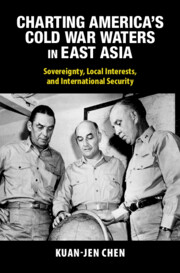 Charting America's Cold War Waters in East Asia
Charting America's Cold War Waters in East Asia Published online by Cambridge University Press: 23 May 2024
The author argues that the policy of non-interference changed when it was suspected that there were oil reserves in the East China Sea. The possible oil reserves under the seabed of the East China Sea indicated in the 1969 Emery report convinced the United States to cooperate with Japan, South Korea, and Taiwan, but they also led to competition between these countries for ownership of these natural resources. The volatile international situation and the changing nature of great-power politics created a dynamic in maritime East Asia that had far-reaching consequences for both America’s alliance network and Washington’s naval deployment in the western Pacific. The author argues that the United States viewed the sea as a dangerous geographical space that could trigger all-out conflict with China and had thus begun to regard the maritime space of East Asia as a buffer zone that would allow it to maintain a distance from China instead of regarding it as a geostrategic barrier for containment. These political and military contours of maritime East Asia were a product of the interaction between Washington’s domestic and foreign policies and the internal dynamics of the East Asian countries.
To save this book to your Kindle, first ensure [email protected] is added to your Approved Personal Document E-mail List under your Personal Document Settings on the Manage Your Content and Devices page of your Amazon account. Then enter the ‘name’ part of your Kindle email address below. Find out more about saving to your Kindle.
Note you can select to save to either the @free.kindle.com or @kindle.com variations. ‘@free.kindle.com’ emails are free but can only be saved to your device when it is connected to wi-fi. ‘@kindle.com’ emails can be delivered even when you are not connected to wi-fi, but note that service fees apply.
Find out more about the Kindle Personal Document Service.
To save content items to your account, please confirm that you agree to abide by our usage policies. If this is the first time you use this feature, you will be asked to authorise Cambridge Core to connect with your account. Find out more about saving content to Dropbox.
To save content items to your account, please confirm that you agree to abide by our usage policies. If this is the first time you use this feature, you will be asked to authorise Cambridge Core to connect with your account. Find out more about saving content to Google Drive.